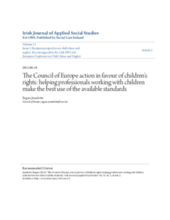Abstract
The Council of Europe offers targeted action in its 47 member states to assist in increasing the protection of children’s rights. Its transversal programme “Building a Europe for and with Children” has focused on mainstreaming children’s rights into all policy areas and developing a holistic child-rights-based approach that is complementary to the United Nations agenda. New standards and policy guidelines have been drafted and adopted. The current strategy for the programme has the goal of promoting these standards and tools and assisting member states to translate, disseminate and implement them in practice. The four areas that are singled out for particular action under the current strategy are: to promote child-friendly services and systems; eliminate all forms of violence against children; guarantee the rights of children in vulnerable situations, and promote child participation. In response to the first action area, Guidelines are available for professionals to help them guarantee children’s effective access to and adequate treatment in justice. This tool is being used by the European Commission and the Fundamental Rights Agency in a study and research project. There are also Guidelines on child-friendly health care to help professionals adapt their working methods using a child-centred approach. A further standard is available on children’s rights and social services friendly to children and families for ensuring that children lacking or placed outside parental care are given adequate treatment. Other areas such as tools in favour of positive parenting and for increased knowledge of democratic citizenship and human rights education, including children’s rights education, have also been developed. Concerning the second area of action to eliminate all forms of violence against children, the main focus has been on combating sexual violence against children. The Council of Europe Convention on the Protection of Children against Sexual Exploitation and Sexual Abuse (Lanzarote Convention) is the key instrument to ensure that states have in place a solid legislative, institutional and practical framework to prevent and combat sexual violence against children. The Council of Europe ONE in FIVE Campaign to stop sexual violence against children (running until November 2015 and followed by a European Day (18 November) on the protection of children against sexual exploitation and sexual abuse), complements the awareness-raising efforts on this subject. Protecting children in vulnerable situations is multifaceted and is covered under the strategy via focused action targeting the rights of children at risk and in care, for which publications have been produced, such as “Discover your Rights!” (for children in care) and Securing Children’s Rights (for the professionals working with children in care). Children in detention and Roma children also figure among the groups of children singled out for deserving particular attention under this heading. Finally, child participation is an area to which the Council of Europe has turned its attention in support of the implementation of Article 12 of the UN Convention on the Rights of the Child. It has just recently launched an Assessment Tool to assist member states in encouraging policy makers and professionals to involve children and to listen to their views. The Council of Europe’s programme is appropriately named in helping its member states to build a better environment upholding children’s rights.

